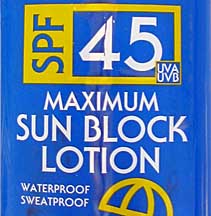Many consumers are being mislead as to the protection they are getting from their sunscreen. Even though more and more people are using sunscreen, incidents of skin cancer are still rising every year.
One problem is that users overestimate the amount of protection they get from sunscreen. In theory, you would multiply the time it takes your skin to burn in the midday sun (say 10 minutes) and multiply it by the Sun Protection Factor (SPF). So a SPF 30 sunscreen would supposedly protect you for 300 minutes.
 But experts say in reality sunscreens give much less protection. Sunscreens wear off with rubbing, sweating and water, and most people apply far less than is recommended. If you calculate you are getting 300 minutes of protection, in actual fact you are probably getting only 80 minutes.
But experts say in reality sunscreens give much less protection. Sunscreens wear off with rubbing, sweating and water, and most people apply far less than is recommended. If you calculate you are getting 300 minutes of protection, in actual fact you are probably getting only 80 minutes. A bigger concern is that sunscreens have very good UVB blockers, but UVA blockers break down quickly in sunlight - leaving the wearer with little or no UVA protection.
Sunscreens that contain "benzophenones, oxybenzone, sulisobenzone, titanium dioxide, zinc oxide, and avobenzone," says the AAD, extends "the coverage beyond the UVB range and into the UVA range, helping to make sunscreens broad-spectrum."
Although scientists have developed standardized methods for measuring UVB, no such standard measurements have been developed to measure UVA sunscreen protection values. The SPF value shown on sunscreen products only relates to UVB rays, and many products allegedly display this rating as if it applied to both UVB and UVA rays - blatantly misleading consumers as to how much protection they are getting from UVA rays.




